Please Take Note: This is a review of the game’s final prototype. The art, game bits, and the rules discussed are all subject to change. The game is being reviewed on the components and the rules provided with the understanding that “what you see is not what you might get” when the game is published. If you like what you read and want to learn more, we encourage you to visit the game’s web page or visit the Kickstarter campaign. Now that we have all that disclaimer junk out of the way, on with the review!
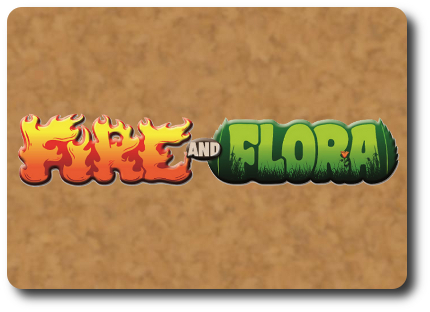
The Basics:
- For ages 8 and up (publisher suggests 12+)
- For 2 to 4 players
- Approximately 60 minutes to complete
Geek Skills:
- Active Listening & Communication
- Counting & Math
- Logical & Critical Decision Making
- Reading
- Strategy & Tactics
- Hand/Resource Management
Learning Curve:
- Child – Easy
- Adult – Easy
Theme & Narrative:
- Help promote ecological growth and health through smart plays and FIRE!
Endorsements:
- Gamer Geek mixed!
- Parent Geek approved!
- Child Geek approved!
Overview
If you walk outside your house, you’ll see plants in abundance. Most people just see a “tree” or a “flower”, but someone who is active in the ecological management of the land sees more. They see a thriving population of native plants or a land being invaded by an enemy. In this game, you take on the role of an ecologist who’s in charge of tending to the natural landscape and helping it thrive, while at the same time protecting it from dangers both foreign and natural.
Fire and Flora, a self-published game designed by Tim Handley, will reportedly be comprised of Resource cards, Event cards, Land cards, Native Plant cards, Invasive Plant cards, Player Reference cards, a custom six-sided die, and an assortment of Coin tokens. We did not list the number of each card type due to the fact that we were handed a prototype version of the game that doesn’t represent the final version. Nor will we comment on the game component quality. What we played with did feel complete and gave all of our players, from the very young to the very old, a solid gaming experience.
Game Set Up
To set up the game, first separate the cards by type. When completed, there will be a deck for Resource cards, Event cards, Land cards, Native Plant cards, and Invasive Plant cards.
Second, look through the Land deck and remove the 4 “Headquarters” Land cards. Place 1 “Headquarters” card in front of each player, face-up. Any “Headquarters” cards not used are returned to the game box.
Third, shuffle the Land deck and place it face-down in the middle of the playing area. Draw the top 5 cards from the deck and place them in a row next to the deck, face-up.
Fourth, shuffle the Resource deck and place it face-down next to the Land deck, making sure to leave enough room for a discard pile.
Fifth, look through the Event deck and remove every Event card that lists a number of players that is greater than the number of players sitting at the table. For example, if playing with only 2 players, the Event cards meant for a 3 and 4-player game would be removed and placed in the game box. Shuffle the remaining cards in the Event deck and place it next to the Resource deck face-down, making sure to leave enough room for a discard pile.
Sixth, take the Native and the Invasive Plant decks and set them to one side of the game playing area. There is no need to shuffle these decks. These two decks represent the “Species pool”.
Seventh, hand to each player 10 Coin tokens and place any remaining, including the custom six-sided die, to one side of the game playing area. The Coins to the side are referred to as the “Coin pool”.
That’s it for game set up! Determine who will be the first player and begin. If playing with 4 players, deal the top Resource card to the 4th player in the turn order sequence. This is a free Resource and helps balance the game.
About the Cards
Fire and Flora is a mix of deck-building and card drafting. Players will be using the different cards listed below to create diverse and prosperous landscapes. Each of the card types and their usage are summarized here.
Land Cards
The Land cards represent different areas found in California, the 3rd largest state in United States of America. These areas are originally owned by the “Bank” and must be purchased by the player during the game. Land cards provide the ground in which players will be planting and nurturing their Plant cards, but players also derive resources from them. All players start with a “Headquarters” Land card that provides 1 Coin and 1 Resource card each round. Note that some Land cards provide special additional abilities and indicate which Native and Invasive Plant cards are placed on them initially.
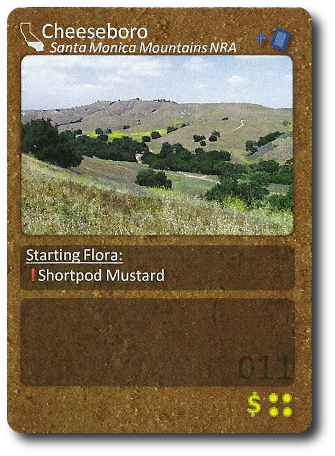
Plant Cards
The Plant cards represent the very real and plentiful flora that can be found across California. There are 11 different sub-types, but each Plant card is played the same. The most interesting aspect of the Plant cards is that they “flourish” and “decline” during game play. One side of the Plant card represents the young or damaged plant and the other represents the same plant in its more mature and healthy form. The Plant cards are exceedingly diverse, and each has their own pros and cons, as well as chances of survival. Some plants are protected from others and most of the plants are affected by the natural elements of time, moisture, and fire (which might or might not be a bad thing for the plant).
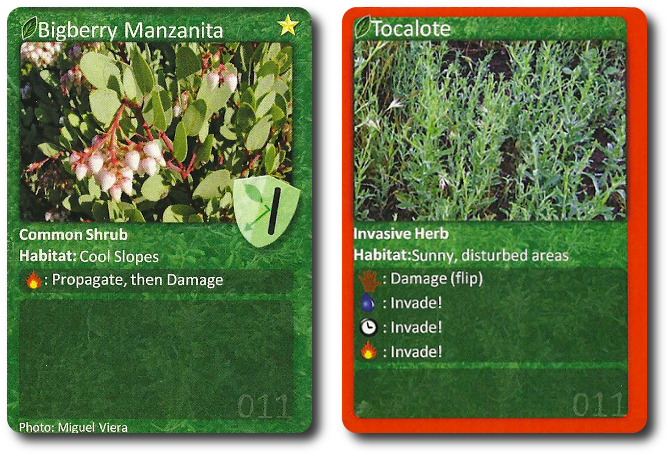
Example of Native Plant card on the left and the Invasive Plant card on the right
Resource Cards
The Resource cards allow the players to take special actions on their own Land and Plant cards, as well as making their opponents’ lives more difficult in the game. There are 8 different sub-types of Resource cards that represent all the elements that impact conversation and land management projects. These include time, water, workforce, and the fire that is meant to destroy invasive plant species or cleverly used to harm the plants owned by opponents. There are also some elements included in the Resource deck that represent the chaotic side of Mother Nature. For example, and my favorite, the “Evil Squirrel” Resource card that allows the player to choose one Invasive Plant card from the Species pool and attach it to ANY Land card with an open (nothing planted on it) space. Thematically speaking, the animal has transported seeds from one location to another, introducing a plant in an environment where it should not be found.
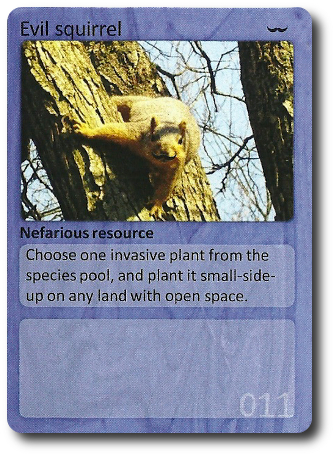
Any squirrel sporting a mustache is up to no good
Event Cards
Event cards represent the random happenings that might or might not be beneficial to the players, their lands, and their plants. Sometimes the Event cards apply to everyone at the table and sometimes only to specific players who have a specific plant species.
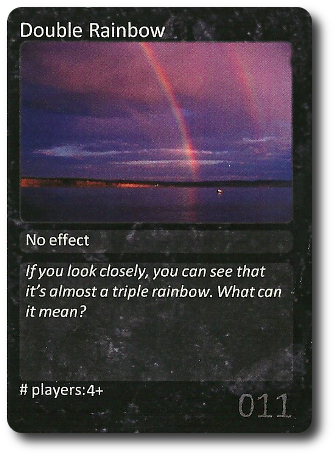
Obscure memes are always good game design
Propagation and Destruction
Fire and Flora, at its core, is primarily focused on the propagation of the native plant species and the destruction of the invasive plant species. The Resource and Land cards are supporting components to the main focus.
Throughout the game, plants will grow. Each plant card has two sides. The initial side represents the plant in its young or damaged state. Through the use of resources (such as time, water, and helpful workers), a plant can mature and flourish, which is represented by the Plant card’s other side. Fire can also play a key role in a plant’s well-being, but it can also just as quickly harm. A quick inspection of a Plant card will reveal that the two sides of the same Plant card are not the same. As the plant matures or is damaged, its overall profile changes, too.
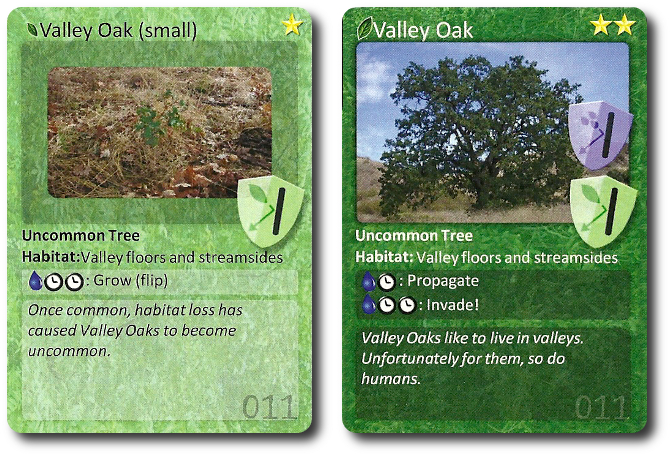
Plants can be damaged and even killed off. Good news for those who are looking to remove invasive species of plants and bad news for those looking to protect the native plants found in the area. Fire is the most leading cause of damaged and eventually killed off plants, but lack of other resources can also contribute to the decline of a plant species. Events play a major role, too. For example, El Niño can bring nourishing rains and damaging floods, and the strong winds of La Niña can cause the smallest spark to burst into a very destructive fire. And speaking of fire, it is as unpredictable as it is destructive. The game includes a custom six-sided die that shows different regions of California. When a fire breaks out, the die is rolled and any players with Land cards in the region identified by the roll of the die are going to have to fight a fire. But, again, fire does not only represent destruction. As the flames consume the Lands in a set pattern around the table, plants might be propagated to neighboring Land cards now vacant of growth but ripe for an invasive or native plant to take root in.
Throughout the game, players will be protecting, attacking, and propagating plants. Players can directly influence their own cards and force their opponents to make some hard choices regarding their Land and Plant cards through strategic game play. When a plant is killed, it’s returned to the Species pool. When a plant is propagated, a plant of the same species is removed from the Species pool and attached to any Land card that currently does not have a Plant card on it. A plant can also invade through propagation. If the plant invading is native to the environment, it pushes out the young invasive species. Of course, if the plant invading is invasive, young native plants are removed. Which is not a good thing.
The Art of Ecological Kung Fu
Fire and Flora is played in turns with no set number of turns per round. A player’s turn is comprised of 5 steps which are summarized here.
Step 1: Reveal Event
The first action the player will take is to reveal a new Event card. The top Event card from the Event deck is drawn and read out loud. The effect of the Event card is immediately resolved by all the players who are affected. The Event card is then placed in the Event discard pile.
Step 2: Reveal Land
The second action the player will take is to draw a new Land card. The top Land card from the Land deck is drawn and placed with any other face-up Land cards. All the face-up Land cards represent property the players can buy and use to obtain victory.
Step 3: Receive Resources
The Land cards the players own provide resources that are needed to help cultivate a healthy and diverse collection of native plants. By default, all players start with the “Headquarters” Land card that provides 1 Coin and 1 Resource card per turn. The player reviews their currently owned Land cards and collects any resources the cards provide. What resources they do provide is noted on the Land card’s upper right-hand corner. All Coins collected are added to the player’s Coin pile and any Resource cards are added to the player’s hand of cards. Because a player will never lose their “Headquarters” Land card, they will always receive (at minimum) 1 Coin and 1 Resource card per turn. Note that some Land cards provide special abilities.
Step 4: Take Actions
The fourth step allows the player to take any number of possible actions and in any order. Every action can be repeated with the exception of buying Land cards, which can only be done once per turn. The actions are summarized here.
Play a Resource Card
The player selects one of their Resource cards from their hand and plays it in front of them, reading the card to the table. The Resource card is immediately resolved and used individually or in tandem with a Plant or other Resource cards. More than one Resource card can be played at the same time. Once the Resource cards are resolved, they are placed in the Resource discard pile.
Get More Resources
If the player needs more resources than what they currently obtain for free from their Land cards, they can spend 2 Coins (returning them to the Coin pool) to draw 1 Resource card. The Resource card can be kept or played right away.
Sell Resources
Of course, it’s perfectly reasonable to expect a player to have Resource cards that provide no value or do not play a pivotal role in the player’s strategy. Such Resource cards are far from useless. They can be “sold” back to the game for 1 Coin. The player discards the Resource card without triggering its effect and then collects 1 Coin from the Coin pool.
Trade
Sometimes a player has enough coins to do what they want, but what they really need is what an opponents has in their possession. A player can propose a trade of multiple Resources, Coins, and Lands with any of their opponents. As long as both sides agree to what is being traded, they can exchange freely. The only cards that cannot be traded are the Plant cards, but any Plant cards currently attached to a traded Land card get moved with it.
Buy Land
Land is not cheap, but it’s plentiful. There are wide and wooly open spaces in California that can be purchased and repurposed to meet the player’s needs. The Land cards that are face-up are the only ones currently available on the market. Included on the Land cards are their cost in Coins. If a player wants the Land card, they pay the amount of Coins indicated by the Land card, placing their Coins in the Coin pool. They then take the Land card and place it in front of them. The vast majority of Land cards will indicate the starting plant species that can be found on the Land card by default. The player looks through the proper Plant deck (Native or Invasive) and removes the Plant card indicated by the Land card. The Plant card is then “planted” on the Land card, “small plant” side face-up. If the Plant card is not found, the land remains open.
Step 5: Count Points
The final step is to count the number of victory points collected so far. Victory points are only provided by Native Plant cards and provide 1 victory point per star icon on the Plant card’s top right-hand corner. By default, the Native Plant card will provide 1 victory point when it’s in its young and less mature form. When the plant is thriving in its more mature form, it can provide up to 2 victory points. Invasive Plant cards, being the “bad guys” in the game, provide nothing beneficial to the player.
If the player has less than 8 victory points, this completes the player’s turn and the opponent to the player’s left (going clockwise) now goes. If the player has 8 or more victory points, the game comes to an end.
Winning the Game
The game continues until a player has 8 or more victory points at the end of their turn. This player is the winner of the game.
To learn more about Fire and Flora, visit the game’s web page or visit the Kickstarter campaign.
Prediction
Fire and Flora is an outstanding example of teaching the importance of ecological conversation though means of gamification. You can sit down with a student and tell them “these plants are bad and these plants are good”, but it’s very difficult to conceptualize something as abstract as “good” or “bad” without having a lot scientific knowledge to understand “why”. I remember having discussions with my father when I was a child about “bad” fish in a lake. It struck me as very strange that a fish could be bad. Weren’t lakes supposed to have fish? But from the perspective of an individual who is looking to protect species of animals and plants, any introduced element that threatens the survival of the “desired” life population is the clear enemy.
Like I said, a bit difficult to conceptualize, but not when you put the same concept into a game. You then take the somewhat abstract and make it much more concrete. Why is this plant bad? Because it doesn’t give you points. Why is this plant good? Because it does gives you points. Exceedingly basic and exceptionally helpful when strengthening the fundamentals of what makes a plant or animal a desirable inhabitant of a certain region.
To say that Fire and Flora has a serious undertone is a poorly worded understatement. Fire and Flora has a very serious message to communicate, but it does not go about it heavy-handed. Nor is it all in your face about the pros and cons, goods and evils, benefits and penalties of ecological resource management. It doesn’t need to because the game is meant to teach this lesson through game play, not pontification. It should come as no surprise that the game designer has experience in the field of quantitative ecology, which is a very fancy way of saying that he looks at a lot of data, analysis it, and identifies trends that can then be acted upon. And, really, I’m terribly over simplifying it. It’s a rigorous discipline that takes a lot of time and a lot of energy, but essential to maintaining a healthy and natural plant and animal population.
We get all the benefits of having the game designed by a scientific mind who recognizes the proper order of things, it would seem. Just based on the game rules, Fire and Flora appears to be very well designed, organized, and intuitive. At first glance, the game actually appears overly simple. Buy land, use resources, and then grow plants. Rinse, repeat, and win. I think that level of simplification is very much in the game, but how the player goes about it and how they act and react to the ever-changing events and limited resources are going to play a major role in a player’s strategy and tactics.
I think Fire and Flora will do very well with the Child Geeks and the Parent Geeks. For both parties, I see the game being both entertaining at the family gaming table and a means to discuss the topics covered in the game in more detail. Fire and Flora is very much a science based game, and science is a lot of fun to talk about. I don’t believe the game will do well with the Parent Geeks at the peer level, however. I see it losing some of its “fun value” with adults only because the subject matter might be of little importance to them or not a theme they find fun to play with. And that brings me to why I don’t think the Gamer Geeks are going to approve Fire and Flora. While I see no reason to believe that the game will be pooh-poohed based on its game mechanisms, I don’t believe the Gamer Geeks will find the game play engaging or overly intriguing. The game play would appear to be very straight forward from a Gamer Geek’s perspective, and unless there is an opportunity to do a lot of messing around with your opponents’ lands, the game will come across as just a limited partnership hand management game. Not a bad thing whatsoever, but the Gamer Geeks might expect more from the game. Especially if the players do not live in California or are not overly interested in plant and land conversation.
Teaching Fire and Flora is a very simple exercise. The game is streamlined and the most complicated aspect of the game is during step 4 where the players need to decide what actions they should take versus the game telling them what actions they need to react to. For our groups, we spent the majority of our time going over the “what’s”, “how’s”, and the “why’s” when it came to the actions available to the players during step 4. None of it really makes much sense, however, until a player actually uses them in the game. At most, expect to go over each and give an example or two. After that, you might have to go into a bit more detail when the game is played. The most frequent questions we were asked regarded plant propagation and destruction.
Teaching it to my 8-year-old was a very easy exercise. Not because he’s overly brilliant (which he is) or has super powers when it comes to understanding games (which he might have), but because I force my poor little geeks to play lots and lots and lots and lots of games. And by “force”, I mean ask nicely and bribe them with juice and graham crackers. Every game played improves the player’s ability to comprehend a new game. There are only so many game mechanisms that can be used and many games use the same game mechanisms or a slight variant. Once you know how to use one or more, every game you play afterwards is a lot simpler to learn. The only aspect of the game that cannot be easily taught is the reading. Players will need to be able to read and comprehend what the card is saying. Parents should feel free to help their Child Geeks, however, as there is no real advantage to knowing what another player has unless the players are highly competitive. And so, after teaching the game to my oldest little geek, I asked him his thoughts on Fire and Flora so far.
“I really like the games that teach something important and are fun to play. I hope this is one of those games.” ~ Liam (age 8)
Me, too. I think all card, board, and dice games provide and strengthen cognitive and emotional skills (commonly refered to by us as the “Geek Skills”), but it’s always a bonus when the game’s theme and narrative is intentionally educational, too. Fun and learning are a wonderful combo. Let’s see if Fire and Flora teaches and entertains in equal measure or should be placed in our compost heap.
Final Word
The Child Geeks had a great time playing Fire and Flora and demonstrated rather quickly a firm grasp of the game’s basic concepts. Only the more mature and skilled Child Geeks demonstrated any meaningful strategy and tactics, however. For the most part, a Child Geek can play the game just fine without really any plan in their head. Buying Land automatically provides resources and victory points (via Plant cards). When they get around to it, the Child Geeks can then improve the Plant card or remove one. If the game had no time limit or defined end-of-game then such game play would suffice, but Fire and Flora is something of a race. Only through proper resource management (both figuratively and literally speaking in game terms) will a player be able to hope to win the game. The older Child Geeks understood this and went gangbusters. The end result was the older Child Geeks having fun and the younger Child Geeks being disappointed when the game was over. According to one of the younger Child Geeks, “I don’t like it when my big brother wins and ends the game because I want to plant more plants.” And in response, the big brother said, “I was just playing to win.” All the Child Geeks voted to approve Fire and Flora.
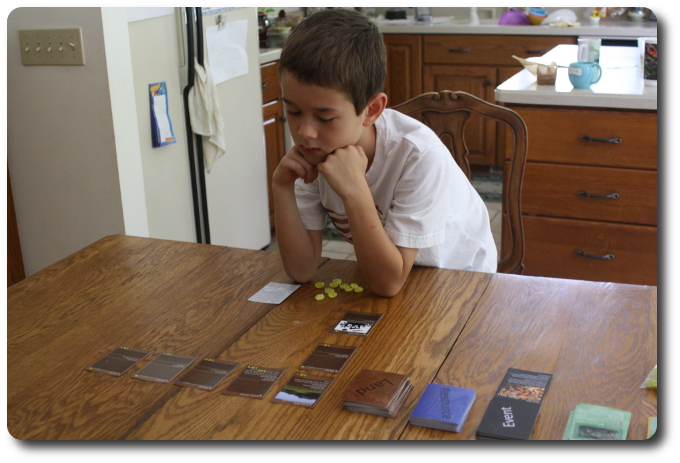
Serious little geek is seriously looking at the cards
The Parent Geeks, as predicted, were very happy with the game at their family gaming table and didn’t have much interest in playing it with just their peers. As a family game, Fire and Flora was very much enjoyed by all. It was entertaining to hear some of the reports of conversations that were held before and after the game was put away. According to one Parent Geek, “I need to borrow this so I can show it to my friend who is a teacher.” Oh, yes! Fire and Flora has tremendous potential as an educational tool! But as a game with just the adults? “No, I don’t think so,” said one Parent Geek. “It’s a good enough game, but I am not looking to play a game that necessarily teaches me something when all I want to do is be entertained and possibly veg out.” A good point. While Fire and Flora is not an overly complicated game, an adult mind has a hard time ignoring the very real lessons being taught underneath its cover. All the Parent Geeks voted to approve Fire and Flora.
The Gamer Geeks both surprised and disappointed me. They surprised me by praising the game’s mechanisms and its tight game play. They very much enjoyed how the plants were able to propagate and how the events felt natural and probable. According to one Gamer Geek, “The game does a great job of taking the very real and intelligently translating it into game mechanisms.” The only factors of the game they didn’t like was the lack of more ways to mess with their opponents and the lack of more interesting Land cards that provided special abilities. When it came to the final vote, the Gamer Geeks were mixed and this is when I became grudgingly disappointed with them.
A number of Gamer Geeks voting to approve the game. According to one Gamer Geek, “This is a good game, plays smart, feels fun, and I enjoyed myself. Those are easy games to vote for.” But not all the Gamer Geeks agreed. According to one of the Gamer Geeks who voted to not approve the game, “I have no interest in a game about this subject matter and I wouldn’t play it if it weren’t for you asking me to.” When I asked for more detail, thinking that perhaps it was the game play that was not appealing to some of the players, none of them suggested that it was the game itself that was not pleasing. “It’s just what the game is about. Nothing more, nothing less. I have no interest in playing games about plants.” Well, OK, fine, but that doesn’t make it a “bad game” or a game that should automatically be rejected based on personal game theme and narrative preference, should it? Apparently, and according to half of the Gamer Geeks we played the game with several times, it most certainly did. Disappointing, but I respect their opinion and vote, even though I don’t agree with their reasoning. The final result was a mixed bag of thumbs up, neutral feelings, and “No Thank You’s” when it came to approving the game or not.
I think Fire and Flora is an excellent example of taking an important concept and communicating it through a medium that both entertains and educates. The game designer has done an outstanding job translating a very scientific area of research and morphing into a competitive resource management game that is easy to learn and fun to play. But most importantly, the “science” behind the game wasn’t dumbed down. It’s very much there, but as an invisible gear that turns the game’s engine. An individual who looks under the game’s hood will be able to see it clearly.
Ultimately, and to be much more objective, Fire and Flora is going to appeal as a game, but might not warrant a play based on its theme. A pity as the game play itself was found to be fun and often times engaging by our players. Is Fire and Flora for you? That will depend, I think, on the answer to two important questions. First, do you enjoy games that teach and educate while at the same time provide fun and a light challenge? If the answer is yes, then Fire and Flora is a game you should look more into. Second, if you are looking for a deeply strategic and tactical game, where players jockey for position and can play aggressively towards each other, then Fire and Flora is not the game for you. You must be competitive to win, but the path to victory is pretty clear, the level of player contact is often times minimal, and the game is very giving when it comes to providing players the means to play cards. As for me, I enjoyed the game and I hope to see it get published.
This is a paid for review of the game’s final prototype. Although our time and focus was financially compensated, our words are our own. We’d need at least 10 million dollars before we started saying what other people wanted. Such is the statuesque and legendary integrity of Father Geek which cannot be bought except by those who own their own private islands and small countries.



